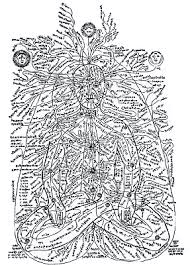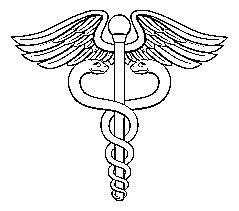The image above is called Caduceus and is a common symbol used in the medical field. The original representation of the caduceus is quite detail and is as followed.
The staff represents the Sushumna, the two snakes represent Ida and Pingla, each time the two snakes cross is where a Chakra is located with the heads of the snakes pointing to Ajna Chakra or the Third Eye Chakra, the round ball on the top of the staff represents Sahasrara Chakra or the Crown Chakra and the wings represent the Divinity within humanity.
In Sanskrit Ida means "comfort," Pingala means "tawny," Sushumna means "gracious" or "kind" and Nadi means "flow" or "stream." Ida is the left nostril, white, represents feminine energy and represents the Moon.
Pingala is the right nostril, represents masculine energy and represents the Sun. From these three main energetic pathways, Sushumna is the most important because it is the spiritual channel.
When all of the energetic pathways are open and free of impurities, this allows Prana to flow unobstructed, allowing Prana to flow through Sushumna bringing the practitioner's mind into a calm and still state.
Sushumna is also the central channel for the seven main Chakras, allowing Prana to flow through each Chakra. Pingala, Ida and Sushumna Start in Muladhara Chakra and is known as the involvement meeting place, then moving upward, meeting at each Chakra and ending at the Ajna Chakra known as the liberated meeting place.
Starting in Muladhara Chakra, Ida and Pingala rise up through the body to the with Ida ending with the left nostril and Pingala ending with the right nostril.
Sushumna is the central energetic pathway, with three smaller pathways which are known as the Vajra, Chitrini and Brahma Nadis through which the Kundalini Shakti moves through the body from just below the Muladhara Chakra at the base of the spine to the Sahasrara Chakra at the crown of the head.
Muladhara Chakra is the junction point of the three main energetic pathway which is known as Yukta Triveni.
These energetic pathways operate in an alternative nature about every sixty to ninety minutes. This can be discovered by checking the flow of the breath through the nostrils. This is done by blocking one nostril, inhaling and exhaling through the open nostril and checking the opposite side. This is known as checking the Swara of the breath.
If the right nostril is easier to breath from, then Pingala is dominate and you are in the parasympathetic nervous system. This is related to our fight or flight response, digestion, allowing for physical activities to be completed and an extroverted mind.
If the left nostril is easier to breath from, then Ida is dominate and you are in the sympathetic nervous system. This gives us the ability to go to sleep at night, relax and the mind is introverted, allowing for mental work to be completed.
If Pingala is dominate at night, sleep will be restless and disturbed. If Ida is dominate while eating, the digestive process may slow down. The main goal of Hatha Yoga is to bring a balance between Ida and Pingala Nadis. This is accomplished through the practices of Shatkarmas, Asanas, Pranayamas, Mudras, and Bandhas.

